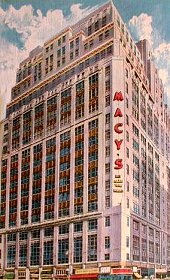|
more 1920s topics Nostalgia Cafe main page Nostalgia Cafe site map | Shopping in the 1920s============================================================ ============================================================ ============================================================ | ||
|
the decade of the chain store During the 1920s, production of consumer goods increased by 43 percent. This created a surplus, and retail chains that had previously been growing at a modest rate began to grow at a phenomenal rate in order to keep up. Chain stores provided a uniform shopping experience and could offer lower prices by buying in bulk. In 1914, there were 24,000 chain stores in the United States. By 1929, this figure had increased to 150,000 stores. Jazz Age Chicago: 1920s Chain Stores 20s Articles About Chain Stores | ----- | |||
|
======================================== ======================================== |
======================================== ======================================== | |||
variety stores drugstores general merchandise J.C. Penney Ben Franklin Woolworth's Walgreens * The first Walgreens drugstore opened in 1901. During the 1920s, the chain grew from 20 stores to 525 stores. *The J.C. Penney empire began in 1902, when James Cash Penney became part-owner of a Golden Rule Store in Kemmerer, Wyoming. He developed his own chain of Golden Rule Stores, which adopted the Penney name in 1913. During the 1920s, J.C. Penney opened 1,200 stores, or an average of one store every three days. | 
Walgreens History J.C. Penney History Ben Franklin Nostalgia 1926 | |||
|
======================================== ======================================== |
======================================== ======================================== | |||
*Before the 1920s, both Sears, Roebuck & Company and Montgomery Ward were strictly mail-order companies. During this decade, competition from the chain stores and the surplus of consumer goods prompted them to open their first retail stores. Sears opened its first store in 1925, and Ward's opened its first store in 1926. By 1929, the Sears chain had already grown to 324 stores. did you know? --Marshall Fields in Chicago sold their first box of Frango mints in 1929  Bon Marche Department Store  Holman Department Store  The May Company | department stores Macy's The Fair Store Saks Gimbel's Marshall Fields Saks Fifth Avenue (1924) Lord & Taylor Bloomingdale's Montgomery Ward The May Company Sears Filene's  Macy's  Poland's Department Store | |||
|
======================================== ======================================== |
======================================== ======================================== | |||
 grocery stores Piggly Wiggly Great Atlantic & Pacific Tea Co. (A&P) National Tea Grand Union Kroger Jewel Tea Many grocery stores still did business the old-fashioned way. Bulk items were sold from barrels, cheese was sliced from the big cheese wheel, and meat was wrapped up in white paper from a big roll at the end of the counter. Canned goods were kept on shelves behind the counter, and the grocer obtained them for you. |  Piggly Wiggly, 1928 The self-service concept was still brand new, but it was catching on. In 1916, the first Piggly Wiggly groceterias allowed shoppers to choose items from the shelves and take them to a cashier themselves. * During the 1920s, the number of Piggly Wiggly stores increased from 500 to 2,500. * The A&P chain had 17,500 stores by 1928. | |||
|
======================================== ======================================== |
======================================== ======================================== | |||
the modern shopping center Small retail centers began to appear in suburban towns in the late 1910s. Usually, these centers consisted of a small cluster of shops, which were sometimes united by a single architectural theme. They were located in the downtown business district, but they differed from typical downtown streets in that they were designed specifically for shoppers. Unlike the shopping centers that would come later, these places were still geared towards pedestrians and streetcar riders, and provided minimal parking space for cars.  The modern shopping center was a product of the automobile age. In the 1920s, downtown retailers were faced with a problem they had never encountered before: where to park all the cars? They turned their attention to the suburbs, where land was cheap and acreage was plentiful. |  In 1922, Country Club Plaza in Kansas City was the first large, modern shopping center. The importance of the automobile was quite evident here. Developers devoted 46 percent of the property to parking lots and streets, and even included a gasoline filling station. Unlike most retail centers, it was more than just a random collection of stores....the Spanish-style buildings were designed as a complete entity, with stucco surfaces, red tile roofs, fountains and lavish landscaping. It was the first retail plaza to be planned, owned and managed by a single developer. Most established retailers were hesitant to open stores in the suburbs, because they didn't want to take business away from their downtown locations. If they did choose to open a suburban branch, the stores were usually smaller and carried a limited inventory. An exception to this was Sears, Roebuck & Company. When they decided to open a chain of retail stores in 1925, they deliberately chose suburban locations. | |||
|
======================================== ======================================== |
======================================== ======================================== | |||
 Shopping downtown at Crandler Outfitters | other stores dress shops appliance stores shoe stores dry-goods stores hardware stores bakeries candy stores *In many areas, the public service company was responsible for providing gas and electric service to homes. During this time, they also operated stores where people could purchase electric appliances. Lamps, toasters, irons and washing machines could all be bought here, usually on the installment plan. | |||

continue to:
Shopping (page 2)
or
return to:
Shopping & Dining
other pages in this section:
Travel & Nightlife
Town & Country
return to the 1920s main page